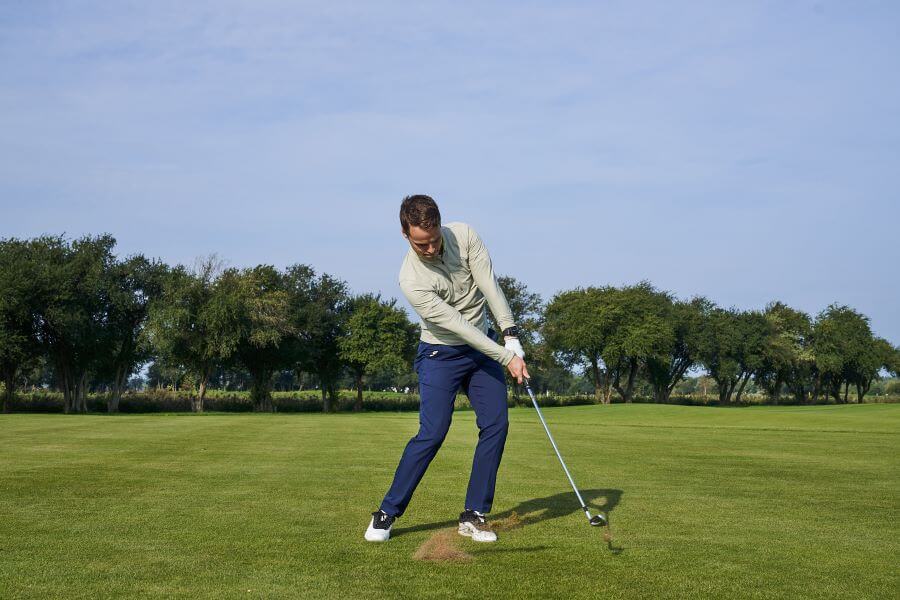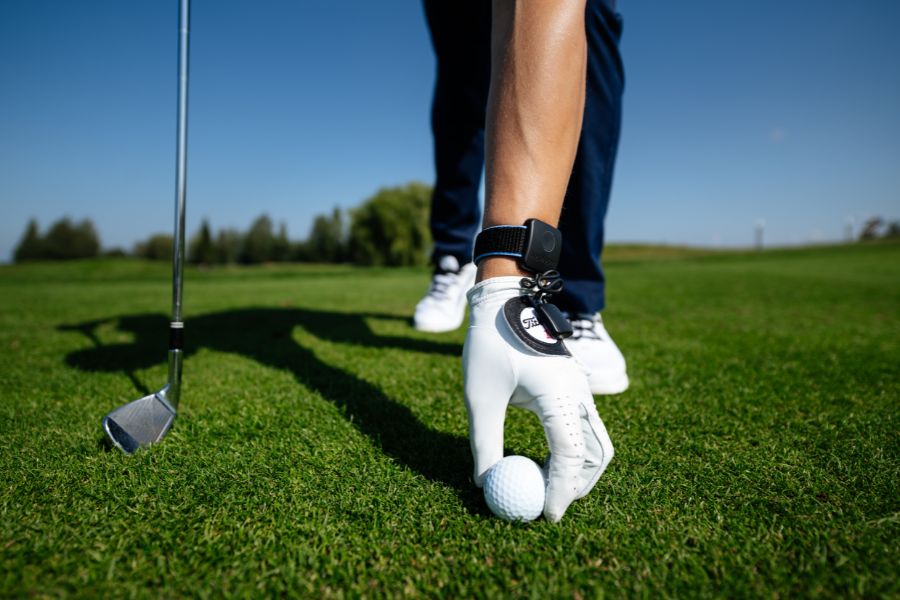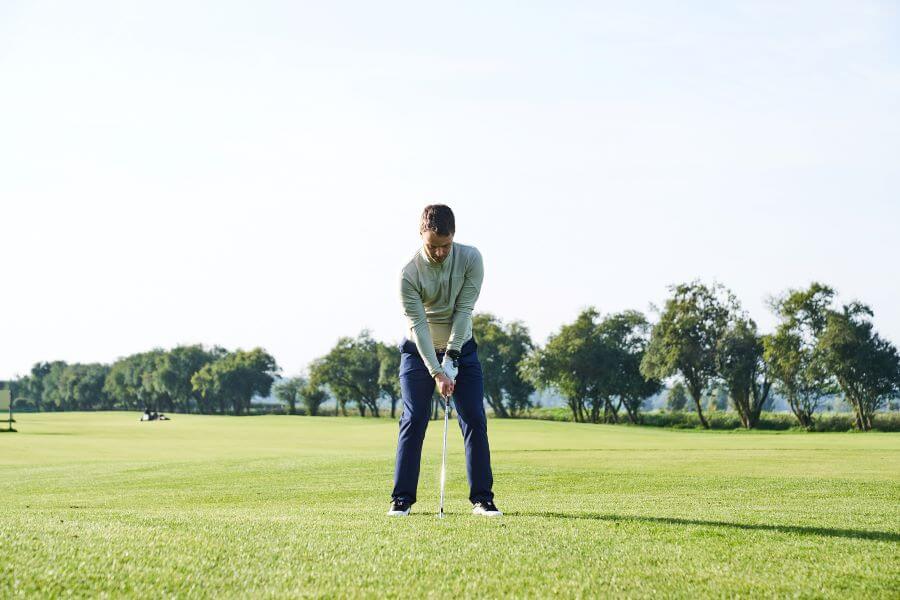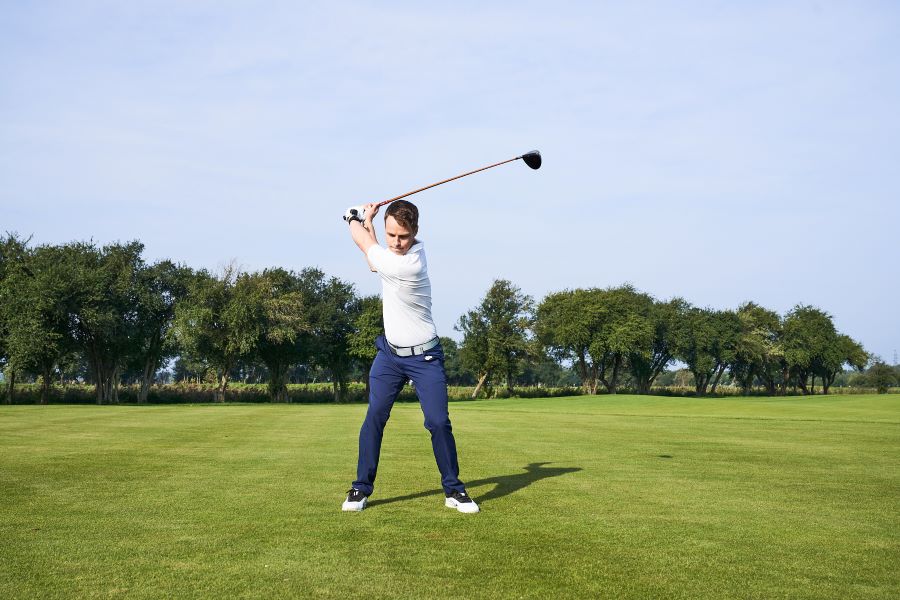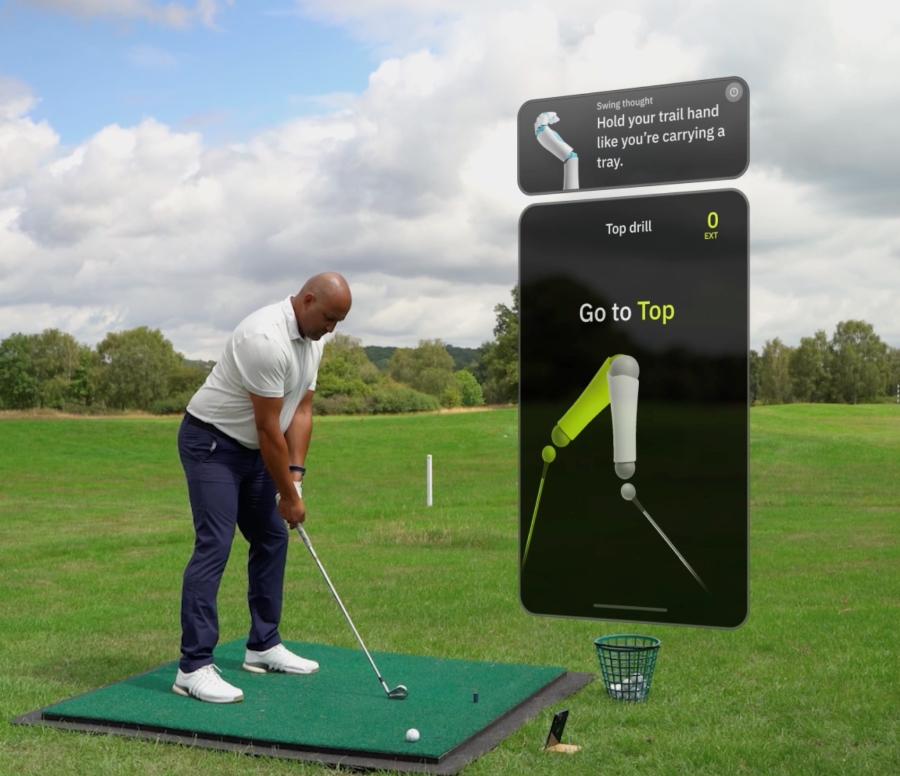Swinging Too Hard in Golf? 8 Tips & Drills to Slow Down Your Swing
One of the simplest ways to prevent overswinging is to shorten the backswing and include a brief pause at the top before transitioning into the downswing.
This creates a smoother rhythm, improves hip and shoulder turn, enhances balance, and leads to cleaner ball striking.
Beyond this quick adjustment, there are several effective ways to slow down the swing: taking more club, using swing training aids, and easing grip pressure. A more controlled approach often produces greater power and distance than a rushed or forced swing.
How to Slow Down Golf Swing (Key Takeaways)
If you don’t have time to work through all of these solutions now, just start with these quick fixes:
- Shorten your backswing and pause briefly at the top for better rhythm.
- Take more club so you don’t feel the need to overswing.
- Lighten grip pressure to stay relaxed and allow natural wrist movement.
- Focus on balance instead of raw speed to improve strike quality.
Contents
8 Ways How to Prevent Swinging Too Hard in Golf
1. Always Take More Club
One of the most common mistakes golfers make is under-clubbing. Choosing a club that forces you to swing harder often leads to tension, poor sequencing, and mishits.
Instead, take more club than you think you need and focus on making a smooth, controlled swing.
A great example is on long par 3s with hazards in front of the green. Many players try to muscle a mid-iron to cover the distance, but that pressure can cause them to come out of the shot or leave it short.
Taking one extra club allows for a ¾ swing with less effort, giving you more consistency and a safer result.
This approach also ties into swing mechanics at the top. Rather than thinking about lengthening the backswing, work on creating a deeper backswing with a longer hand path, which promotes better wrist positioning and more efficient power. You won’t need to force the shot so much.
2. Lighter Grip Pressure
Gripping the club too tightly creates tension in the shoulders and arms, which restricts your ability to release the club and square the face at impact.
Excess pressure also limits rotation and forces you to generate speed mainly with your arms, often leading to hard, unbalanced swings.
A lighter grip encourages freedom of movement. It allows the wrists to hinge naturally from the top of the swing, guiding the clubface smoothly into the ball.
With less force and more rhythm, you’ll find it easier to maintain balance and produce a cleaner strike.
3. Shorten Your Backswing
Trying to swing past parallel often leads to balance issues, too much arm motion, and an open clubface at impact.
At the top of a long backswing, the lead wrist tends to move into excessive extension, making it nearly impossible to square the clubface consistently.
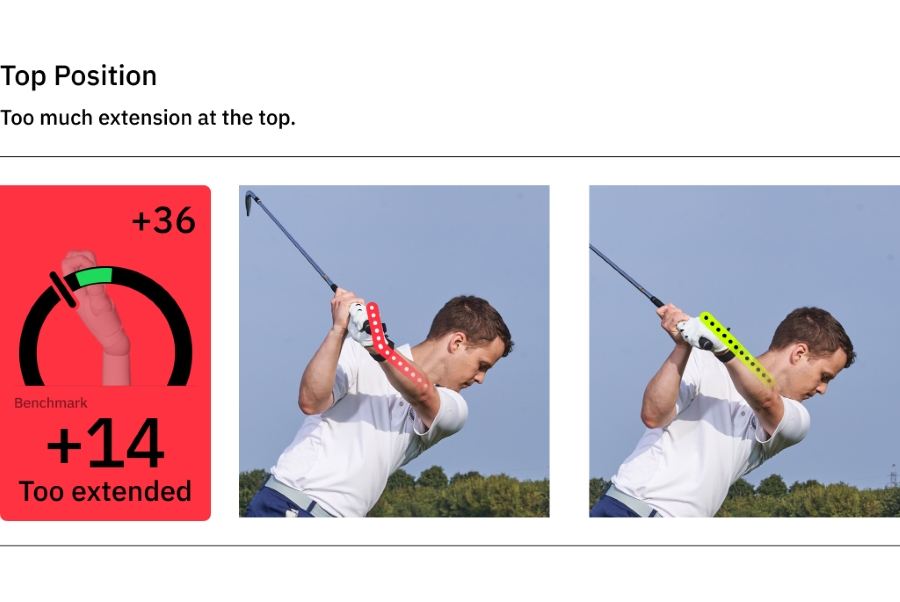
The key is to stop at parallel and focus on a deeper turn with the hips and shoulders, rather than forcing length with the arms.
HackMotion data shows that elite players maintain stable wrist angles from setup to the top, without adding unnecessary extension.
By shortening the backswing, you create more efficient rotation, better rhythm, and a cleaner strike.
Drill: Combined Top Drill
This drill helps you train an optimal top-of-swing wrist angle at full speed:
HackMotion Combined Top Drill – Step by Step
- Full-Speed Backswing – Address the ball normally with HackMotion on. Make a rapid backswing like a real shot, no pausing.
- Check Wrist Angles at the Top – As soon as you reach the top, confirm you’re in the HackMotion green zone.
- Transition & Swing Through – From that position, swing down smoothly, blending the correct top position into your downswing.
- Refine – Start with short pauses at the top, then gradually reduce them until you can hit the position naturally at speed.
4. Getting The Right Positions
Most golfers swing too hard because they believe power comes from effort.
In reality, true power comes from putting the club in the right position at the right time.
The most important position of all is at impact. A square clubface paired with a flexed lead wrist leads to straighter, higher, and more consistent shots.
You don’t need to swing harder to gain distance, just get into the correct positions.
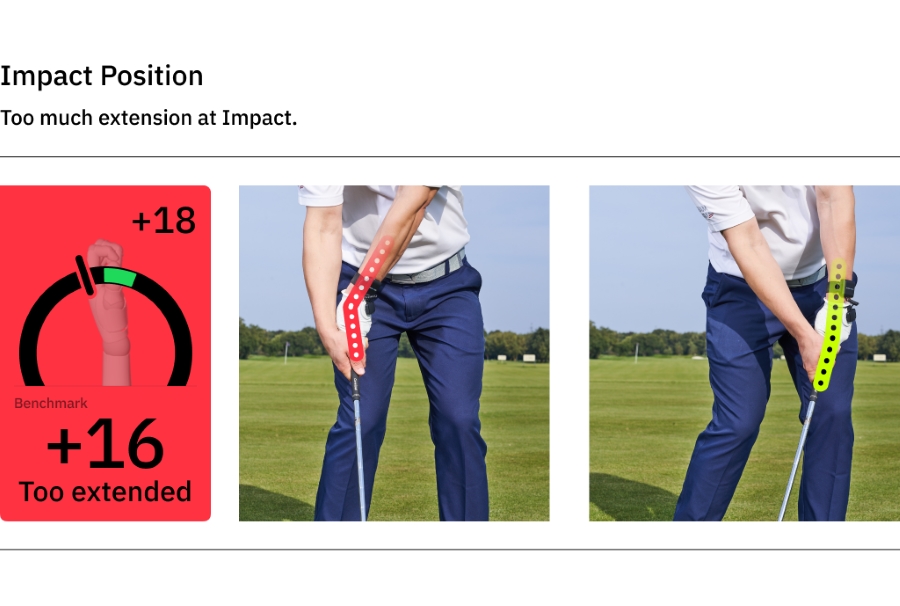
HackMotion makes this visible by showing whether your clubface is square at the top and whether your lead wrist moves from extension into flexion through impact. When these positions line up, you generate effortless power while maintaining control.
So next time you think about speed, remember: position creates power. Get the club in the right place, and distance will follow naturally.
5. Pause at the Top of Your Backswing
A brief pause at the top isn’t meant to be a permanent move like Hideki Matsuyama’s, but it’s a great training tool on the range.
By deliberately stopping at the top, you remove momentum from the backswing and force yourself to start the downswing with proper sequencing.
How to practice it:
- Make your normal backswing and pause for one full second at the top.
- Focus on feeling your hips and shoulders rotate to start the downswing, not your arms.
- Swing through smoothly, keeping your rhythm even.
This simple drill teaches that real clubhead speed comes from rotation and timing, not from throwing your arms at the ball. Over time, it builds a better rhythm and consistency that you can take to the course.
6. Optimize Shoulder and Hip Rotation
Limited hip and shoulder rotation forces golfers to rely too much on their arms, leading to weak and inconsistent shots. Proper rotation, on the other hand, creates the foundation for both power and accuracy.
At the top of the backswing, an efficient swing typically produces around 45 degrees of hip rotation and 90 degrees of shoulder rotation relative to the spine.
While not every golfer will reach those numbers, aiming for more depth in your turn, rather than just length with your arms, helps generate effortless clubhead speed.
The goal isn’t to copy tour players exactly, but to find a balanced rotation that maximizes your body’s potential. Better rotation means more consistent strikes, more distance, and less strain on your swing.
7. Increase Flexibility
Good rotation depends on a body that can actually move through the swing. Without flexibility, it’s nearly impossible to achieve the shoulder and hip turn needed for power and rhythm.
Here are three simple stretches that target key golf muscles:
- Twisting Stretch – Opens up the thighs, lower back, and hips to prepare your body for a full turn.
- Scarecrow Twist – Teaches the shoulders and hips to rotate together, mimicking the motion of your backswing and downswing.
- Piriformis Hip Stretch – Loosens tight hips, making it easier to start the downswing with proper rotation.
Adding these to your warm-up keeps your core muscles engaged and improves your ability to rotate smoothly, creating a cleaner swing with less effort.
8. Let the Arms Fall Downwards
One of Tiger Woods’ key principles is allowing the arms to fall in front of the chest from the top of the swing.
This simple move keeps the downswing connected and lets the body’s rotation and weight shift generate speed, rather than forcing it with the arms.
When the arms fall naturally, the legs and torso drive the swing, creating effortless power and more consistent strikes.
A common mistake, however, is casting—throwing the club from the top. This early release robs you of stored energy and often leads to weak, off-line contact.
Drill: Casting Drill
Use this HackMotion drill to train the right sequence and keep your arms falling into place:
HackMotion Casting Drill – Step by Step:
- Slow Rehearsals – Make a normal backswing. Start the downswing by shifting weight to the front side and rotating the hips. Avoid pulling down with the arms.
- Maintain Trail Wrist Bend – With HackMotion, monitor your trail wrist. Keep it extended (bent) as you begin the downswing; don’t let it straighten too early.
- Arms Follow – Allow the arms to drop naturally. The club should “lag” behind your hands, storing power for release later.
- Progressive Speed – Start at slow speeds and gradually increase. Use HackMotion graphs to ensure your trail wrist maintains extension until just before impact.
Summary
There’s a fine line between accelerating through the ball and simply swinging too hard.
Overswinging often leads to lost balance and inconsistency, while a controlled swing produces both power and accuracy.
HackMotion makes it clear where extra effort disrupts your mechanics. The data shows that clubface control matters more than raw speed, and that’s the key to hitting better golf shots.






